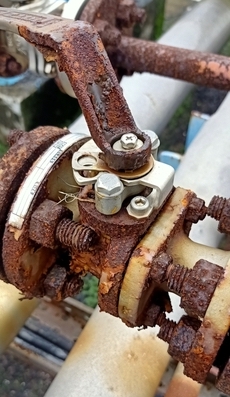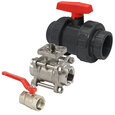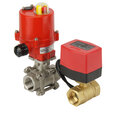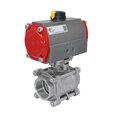Ball Valves For Corrosive Media: Material Selection And Selection Guide

Figure 1: Corroded ball valve made of carbon steel
Ball valves are widely used in various industries that deal with corrosive media, such as chemical processing, oil and gas, water treatment, and pharmaceuticals. When handling corrosive media, choosing the right ball valve materials is crucial to ensure the safety, efficiency, and longevity of the valve.
Ball valves are preferred over other valves in corrosive environments for several reasons.
- Simple design: Ball valve design minimizes the number of components susceptible to corrosion. Ball valves have fewer internal parts than other types of valves, such as globe valves or gate valves, which means fewer surfaces for the corrosive environment to attack.
- Tight shut-off: Ball valves have a ball-shaped disc that rotates to control fluid flow through the valve. When the ball is in the closed position, it forms a tight seal with the valve body, preventing any leakage. This design makes ball valves ideal for use in environments where the slightest leakage can cause significant problems.
View our online selection of ball valves!
Causes of corrosion in ball valves
Corrosion is the gradual destruction of metal due to chemical or electrochemical reactions with the surrounding environment. Corrosion in ball valves can lead to leaks, valve failure, and other operational issues like the ball getting stuck inside the valve.
Several factors, including exposure to harsh chemicals, high temperatures, and high-pressure environments, can cause corrosion in ball valves. Ball valves can get corroded due to multiple reasons.
- Exposure to corrosive environments: Ball valves made of certain materials, such as carbon steel or cast iron, are susceptible to corrosion when exposed to corrosive environments, such as seawater or acidic solutions. Corrosion can also occur when the valve comes into contact with substances like acids, alkalis, and chlorine.
- Galvanic corrosion: Galvanic corrosion is caused when two dissimilar metals are in contact with each other in the presence of an electrolyte. In ball valves, this can occur when different materials are used for the body, ball, and stem. If these materials have different electrochemical properties, the flow of electrical current can cause corrosion.
- Erosion-corrosion: Erosion-corrosion is caused by mechanical wear and chemical attack. This can occur in ball valves exposed to high-velocity flows or abrasive fluids. The mechanical action of the fluid can remove the protective oxide layer on the valve surface, exposing the underlying metal to corrosion.
- Microbial-induced corrosion: Microbial-induced corrosion (MIC) is caused by microorganisms, such as bacteria and fungi, that can colonize the surface of ball valves. These microorganisms can produce acids and other corrosive substances that can attack the metal surface, causing corrosion.
Selecting ball valves for corrosive environments
There are several ways to deal with corrosive media when using ball valves in industrial applications.
Material selection
General materials
Materials such as stainless steel or plastic may be used depending on the application. These materials are known for their corrosion-resistant properties and can withstand exposure to harsh chemicals and environments.
- Stainless steel 316 is recommended for highly corrosive and high-pressure environments, while grade 304 stainless steel is suitable for mildly corrosive environments. However, stainless steel is costly. Learn how to select between stainless steel 316 and 304 in our detailed article.
- Plastic ball valves, such as PVC, PP, or PVDF are highly resistant to corrosion but may not be suitable for high-temperature and high-pressure applications. They typically have a max temperature rating of 60 °C (140 °F). Plastic ball valves are cost-effective compared to stainless steel valves, hence suitable for general purpose applications with corrosive media.
- Seals such as FKM, teflon, or EPDM, can provide excellent sealing performance in corrosive environments.
The effect of concentration, pressure, and temperature
Different materials are affected by different substances and conditions in different ways, making it difficult to choose the right one. For example, low concentrations of sulfuric acid can corrode steel, but high concentrations can create a protective film. Hydrogen only corrodes steel under high temperatures and pressure, while chlorine is not very corrosive when dry but can be very corrosive in humid conditions. Choosing the right material for the valve body involves considering factors like pressure and temperature resistance, cost, and availability, not just corrosion prevention. Table 1 shows the compatibility of common corrosive media with typical ball valve materials. Also, refer to our chemical compatibility chart for the compatibility of more corrosive media with different valve materials.
Table 1: Material compatibility of common corrosive media
| Media | Ball valve material information |
| Sulfuric acid |
|
| Hydrochloric acid |
|
| Nitric acid |
|
| Chlorine |
|
| Ammonia |
|
| Alcohols, Ketones, Esters, Ethers |
|
Coatings
Coatings on valves (like zinc) in corrosive environments act as a protective barrier that prevents the underlying valve material from reacting with corrosive substances. A hard chromed ball in ball valves provides a wear-resistant and corrosion-resistant surface, enhancing the valve's durability and ensuring smooth operation in demanding environments.
Other factors
Ensuring proper valve installation and maintenance can help prevent corrosion. Proper installation includes using appropriate gaskets and sealing materials and ensuring the valve is properly aligned and secured. Regular maintenance includes cleaning and inspecting the valve for any signs of corrosion. Learn more about corrosion prevention in our anti-corrosion measures for valves article.
FAQs
What materials are recommended for ball valves in corrosive environments?
Common materials used for ball valves in corrosive environments include stainless steel, brass, and plastic. The selected material should have high corrosion resistance based on the specific corrosive media.
How can I reduce the impact of corrosion on my ball valve?
Proper installation, regular maintenance, and coatings and platings can all help reduce the impact of corrosion on a ball valve. Selecting the right type of ball valve can also help reduce corrosion.









